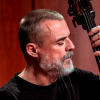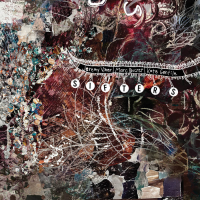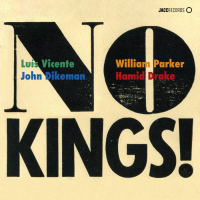Home » Jazz Articles » Album Review » Roberto Bonati: Vesper and Silence
Roberto Bonati: Vesper and Silence
The label's small but consistently creative and artistically experimental discography matches the festival's expansive purview, which explores both written and improvised music (and the nexus where the two meet). It is largely devoted to documenting works and projects germinating or performed at (but not exclusive to) the ParmaFrontiere festival, and that includes Bonati's marvelous 2019 solo bass outing, Vesper and Silence, recorded live in August, 2017. This 63-minute, 12-piece recording amply demonstrates, perhaps more than in any of the many other contexts in which Bonati has participated, the double bassist's broad musicality, deep vernacular and remarkable instrumental acumen, qualities which he has applied to other recordings in his own discography, and through his work with artists including, amongst many others, fellow Italians Mario Piacentini and, most notably, Gianluigi Trovesi.
Well known for his series of ECM recordings, including one-off projects like 2007's trio date Vaghissimo Ritratto and 2009's more ambitious All'Opera session, Profumo Di Violetta, Trovesi's more recent work is even better recognized for the clarinetist/saxophonist's longstanding collaboration with accordionist Gianni Coscia, the pair having released four albums for the label since 2010. Still, one of Trovesi's finest ensembles remains his Ottetto (Octet), featuring two bassists (including Bonati) and which, following two equally fine releases on Italy's Soul Note imprint (1992's From G to G and 1996's Les Hommes Armés), was responsible for its to-date high watermark, Fugace (ECM, 2003).
In addition to recording with Piacentini on the (sadly) almost impossible to find Circles (Nueva, 1991), Bonati has appeared on more recent, easier to locate recordings from the keyboardist like Néant (Incipit, 2014). A sparkling sextet date that, in addition to Bonati, drummer Marco Tonni and guest Trovesi, also includes another ECM label stalwart, Russian French hornist Arkady Shilkloper, alongside Norwegian saxophonist Tor Yttredal in the front line, delivering a standout performance at the 2014 Mai Jazz festival in Stavanger, Norway.
Yttredal is far from Bonati's only connection to his northern European cousins. Like earlier works including Rêve de Jongleur (MM, 2000), its music seamlessly spanning centuries through Bonati's innovative blending of modern jazz orchestra and Gregorian choir, and A Silvery Silence: Fragments from Moby Dick (MM, 2006), where Bonati's music, like its source (Herman Melville's classic novel), explores the dichotomies of horror and beauty, awe and obsession, the bassist's work with Norwegians met during his many trips to the country (both in his capacity as a musician and as ParmaFrontiere's Artistic Director) have often been conceptual in nature.
Bonati first collaborated with Norwegians at Oslo's renowned Norwegian Academy of Music in 2012, conducting his 2007 Snow Flower orchestral composition dedicated to the Japanese tradition of haiku. This led to a 2015 commission from the University of Stavanger's 18-piece Bjergsted Jazz Ensemble, with Bonati further expanding upon his burgeoning career as composer and conductor, writing a new book of music inspired by Norse mythology documented in antiquated, anonymous Nordic poetry, resulting in the 2016 ParmaFrontiere release, Nor Sea, Nor Land, Nor Salty Waves.
Bonati now divides his time between programming the ParmaFrontiere festival and furthering his reputation as both a versatile double bassist and his growing renown as a composer and conductor. It's also resulted in an increasingly active release schedule on the ParmaFrontiere imprint, with Bonati releasing four recordings since Nor Sea, Nor Land, Nor Salty Waves.
2018 saw the release of Il Suono Improvviso, a DVD featuring Bonati conducting the massive, 45-piece Chironomic Orchestra in a program developed for the festival's 20th anniversary. Despite there being no formally written score, the ensemble is directed, through Bonati's specific gestures and signs, to fashion a program rich with extemporaneous explorations, yes, but also possessed of a narrative that may be different every night, but is a narrative nonetheless.
The same year saw the release of Norwita, a Norwegian/Italian collaboration based on Piacentini's Néant sextet. With the keyboardist, Bonati, Tonin and Yttredal all returning from Néant, the quintet achieves a closer-to-equitable balance between the two countries with the recruitment of trumpeter Tore Johansen, with every member of the group contributing one or more of its nine original compositions.
Along with Vesper and Silence, Whirling Leaves was also released in 2019 (another Chironomic Orchestra session), but it's Bonati's solo bass record that serves as either a potent introduction or, for those familiar, a vivid reminder of Bonati's impressive instrumental skills and ability to pull form from the ether, in this stunning example of largely spontaneous, in the moment composition.
Vesper and Silence focuses attention on the many different aspects of Bonati's virtuosity, creative spirit, ability to seamlessly move from avant-leaning ideations to profoundly felt lyricism...and the many things found in the spaces in-between. The ten-minute title track opens the album with Bonati initially using his big-bodied instrument as a percussion instrument, with copious amounts of reverb allowing him to hit various parts of his bass' body to evoke sounds ranging from deep, almost tympani-like textures to more attack-driven colors, an effective means of drawing the audience at Parma's Abbazia di Valserena into his sound world.
The percussive intro leads to a spare, melody rich passage of the bowed bass that dominates Vesper and Silence, one that spotlights Bonati's firm control over harmonics and his acute attention to both tone and timbre as he renders space and the slow decay of notes as co-equal partners in the gentle melodies drawn from his instrument. A sudden foray into more oblique territory, but only for a moment, leads to "Morning on a Winter Shore," an even more melodic piece where the sudden sound of a cough in the hall renders clear that this is, indeed, a live recording, and that Bonati clearly has no problem keeping it in, almost as if it were a part of the performance.
Morning might imply something more joyous, but the four-minute "Morning on a Winter Shore" is, instead, imbued with a deeper sense of melancholy as Bonati begins to expand outwards from his spontaneous themes, moving between upper and lower registers as he turns more oblique for the piece's second half, also alternating between phrases and percussive injections, this time using his bow to strike (rather than bow) his bass' strings, bridge and body.
A series of angular harmonies, as Bonati simultaneously bows across two strings, leads to "Fifth by Fifth," a brief miniature that, indeed, revolves in part around harmonic fifths. Another con arco piece, it evolves into the similarly brief "An Angel Game," where delicate harmonic filigrees shift the program, once again, towards more melodic concerns, though Bonati's idea of melody remains somewhat left of center.
While Vesper and Silence still a contiguous piece of music at this point, the delicate bowed work of "An Angel Game" leads, quite suddenly, into "Mr on Hammer on," Bonati's first (and only primarily) pizzicato piece that, like its title suggests, is at least partly based upon the use of hammer-ons, where the bassist uses the strength of his left hand to deliver notes based upon his fingers merely striking the neck of his bass, or pulling off one note into the next. A lot happens in just under five minutes, as Bonati then begins to develop motifs, phrases from which he leads from one idea to the next while, at the same time, occasionally returning to earlier ones in order to provide a focused sense of construction, even if it is spontaneously composed.
Bonati is, in fact, more about creating pieces with some kind of shape or form than improvisational extremes, whether it's his continued development of thematic constructs during "October 13" or the chiming metal percussion used at the start of "Campane." Here, the bassist returns to employing his bow for the album's longest piece, an exploration of the antinomies found as he initially alternates between these two vastly different colors before what becomes a true arco tour de force, his seemingly effortless control of natural and harmonic tones all the more remarkable for his rapid shifts between them. The piece slowly turns to a more rhythmically propulsive section, where harmonies are made all the more jagged through brief, sharp bowing, before Bonati returns to a more mellifluous passage that continues to demonstrate Bonati's wonderful, expansive tone, ranging from piercing upper register harmonics to deep, in-the-gut, low register phrases.
"Campane" also possesses some of Bonati's most virtuosic work, as he moves between rapidly bowed harmonic phrases and sharply struck percussive lines and chords, leading to some of the album's freest, most idiosyncratic explorations of tone, technique and creative flights of fancy as the bassist leads into another miniature, "Trumpeting and Dance," one of Vesper and Silence's most eminently knotty tracks. "The Eternal Spiral," on the other hand, revolves around low-to-high register motifs and the relentless pulse they create, resembling how Philip Glass might, were the composer to write for solo double bass.
Still, Glass' rigidly structured compositions are a far cry from Bomati's in-the-moment creations, with "The Eternal Spiral" suggesting a whirling dervish that leads to some most unusual, behind the bridge playing and Vesper and Silence's first break for applause, following nearly fifty minutes of continuous music.
As per Bonati's brief liner notes, where he defines the album as "a musical journey through composition and improvisation," the album's closing thirteen minutes begin with a brief yet haunting solo bass version of "Solveigs Sang" ("Solveig's Song"), from Edvard Grieg's well-known 1875 suite, Peer Gynt, inspired by (and performed together for the first time the following year) Henrik Ibsen's 1867 play of the same name. Grieg's suite may be best known for "In the Hall of the Mountain King" (performed or referenced by artists ranging from Rick Wakeman, Marillion and Electric Light Orchestra to Trent Reznor and Atticus Ross...even hard rock bands like Big Brother and the Holding Company and The Who, but "Solveigs Sang" possesses a surprisingly familiar melody.
Bonati initially delivers "Solveigs Sang" relatively faithfully while, still, in a beautifully interpretive fashion as it segues into "Sabbie Bianche." Like much of Vesper and Silence, "Sabbie Bianche" is played with a bow, a slowly evolving piece that explores many of the techniques that Bonati has used throughout the album to this point, including the use of reverb and the body of his instrument to bring the album to a percussive full circle. "Melodia d'Ottobre" closes Vesper and Silence on a dark but lyrical note, though its middle section briefly alludes to Bonati's more skewed side. The bassist demonstrates a particularly strong, intuitive ability to find his way from greater extemporizations to a firm and conclusive ending that puts a fine period on both the piece and the overall performance.
Solo bass recordings can, for some, be a challenging proposition, but in Bonati's hands, even when the music reaches for some greater extremes, Vesper and Silence is a double bass master class that commands, compels and captivates from start to finish. A masterful virtuoso who always places the music ahead of meaningless pyrotechnics, Bonati demonstrates why, with Vesper and Silence, he's worthy of both the accolades he's already achieved and, indeed, the greater exposure that he most certainly deserves.
Track Listing
Vesper and Silence; Morning on a Winter Shore; Fifth by Fifth; An Angel Game; Mr on Hammer on; October 13th; Campane; Trumpeting and Dance; The Eternal Spirit; Solveigs Sang; Sabbie Bianche; Melodia d’Ottobre.
Personnel
Roberto Bonati
composer / conductorRoberto Bonati: double bass.
Album information
Title: Vesper and Silence | Year Released: 2019 | Record Label: Parmafrontiere
Tags
About Roberto Bonati
Instrument: Composer / conductor
PREVIOUS / NEXT
Support All About Jazz
 All About Jazz has been a pillar of jazz since 1995, championing it as an art form and, more importantly, supporting the musicians who make it. Our enduring commitment has made "AAJ" one of the most culturally important websites of its kind, read by hundreds of thousands of fans, musicians and industry figures every month.
All About Jazz has been a pillar of jazz since 1995, championing it as an art form and, more importantly, supporting the musicians who make it. Our enduring commitment has made "AAJ" one of the most culturally important websites of its kind, read by hundreds of thousands of fans, musicians and industry figures every month.




















